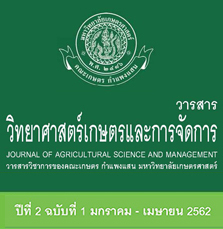อิทธิพลของสมบัติดินและสภาพอากาศต่อการผลิตมะเขือเทศเชอรี่ CH 154
คำสำคัญ:
สมบัติดิน, สภาพอากาศ, การผลิตเชิงคุณภาพ, การผลิตเชิงปริมาณ, มะเขือเทศเชอรี่บทคัดย่อ
งานวิจัยนี้มีวัตถุประสงค์เพื่อศึกษาอิทธิพลของสมบัติดินและสภาพอากาศที่มีผลต่อการผลิตมะเขือเทศเชอรี่ CH 154 ทั้งเชิงคุณภาพและปริมาณ โดยเก็บตัวอย่างในจังหวัดนครปฐมและจังหวัดสุพรรณบุรีทั้งหมด 4 แห่ง สามารถจำแนกได้ 3 ชุดดิน ได้แก่ ชุดดินบางเขน อยุธยา และกำแพงแสน และรวบรวมข้อมูลสภาพอากาศเป็นรายวัน เก็บตัวอย่างดินวิเคราะห์สมบัติทางเคมีได้แก่ pH, %OM, %N, EC, Avai. P, Exch. K, Extr. Fe, Mn, Cu และ Zn รวมทั้งวิเคราะห์ปริมาณไลโคปีน และปริมาณของแข็งที่ละลายได้ทั้งหมด (Total soluble solid; TSS) ผลการทดลองพบว่าสมบัติดินและสมบัติเชิงคุณภาพของมะเขือเทศมีความแตกต่างอย่างมีนัยสำคัญระหว่างชุดดิน โดยมีค่า pH 4.37-6.64 ปริมาณไนโตรเจนทั้งหมด (Total N) ต่ำมาก มีค่าน้อยกว่า 0.15 % ฟอสฟอรัสที่เป็นประโยชน์ (Avai. P) สูงถึงสูงมาก โพแทสเซียมที่แลกเปลี่ยนได้ (Exch. K) มีปริมาณต่ำถึงปานกลาง ค่าการนำไฟฟ้า (EC) น้อยกว่า 3 dS/m จุลธาตุส่วนใหญ่มีปริมาณสูง ปริมาณไลโคปีน 3.30-5.70 mg/100ml TSS มีค่าระหว่าง 9.23-12.70 oBrix ปริมาณผลผลิตไม่แตกต่างกันทางสถิติ มีค่า 1.5-4.0 ton/rai ผลจากการวิเคราะห์ความสัมพันธ์พบว่าการผลิตเชิงคุณภาพและปริมาณไม่มีความสัมพันธ์กับธาตุไนโตรเจน ฟอสฟอรัส และจุลธาตุในดิน อย่างไรก็ตามพบว่า Exch. K และ EC มีความสัมพันธ์เชิงบวกกับไลโคปีนและTSS ที่ r 0.67 ถึง 0.95 สำหรับปัจจัยสภาพอากาศ พบว่าข้อมูลสภาพอากาศตลอดระยะเวลาปลูก มีอุณหภูมิเฉลี่ยใกล้เคียงกัน อุณหภูมิต่ำสุด-สูงสุดเท่ากัน แต่ร้อยละจำนวนวันที่มีอุณหภูมิสูงกว่า 25 oC ปริมาณฝนและร้อยละจำนวนวันฝนตกของชุดดินบางเขน มีน้อยกว่าจุดอื่นอย่างเด่นชัด ซึ่งสภาพอากาศดังกล่าว (ร้อยละจำนวนวันที่มีอุณหภูมิสูงกว่า 25 oC ปริมาณฝนและร้อยละจำนวนวันฝนตก) มีความสัมพันธ์เชิงลบกับไลโคปีนและTSS ที่ r มากกว่า -0.78 แต่สัมพันธ์เชิงบวกกับปริมาณผลผลิต
เอกสารอ้างอิง
กรมพัฒนาที่ดิน. 2561. ตารางการปลูกพืชทนเค็ม.
http://mordin.ldd.go.th/nana/web-ldd/soil/Page09.html.
ทัศนีย์ อัตตะนันท์ และ จงรักษ์ จันทร์เจริญสุข. 2542. แบบฝึกหัดและคู่มือปฏิบัติการวิเคราะห์ดินและพืช. ภาควิชาปฐพีวิทยา คณะเกษตร มหาวิทยาลัยเกษตรศาสตร์, กรุงเทพฯ.
พงษ์สันติ์ สีจันทร์, นภาพร พันธุ์กมลศิลป์, ปุญญิศา ตระกูลยิ่งเจริญ, นายศุภชัย อำคา, เธียร วิทยาวรากุล, ฝอยฝา ชุติดำรง และจิรวัฒน์ พุ่มเพชร. 2554. สภาวะธาตุอาหารพืชและปัจจัยทางดินเพื่อการฟื้นฟูทรัพยากรดินและการใช้ประโยชน์ที่ดินอย่างยั่งยืนในพื้นที่เกษตรกรรมโครงการหลวง ปี 2554. การประชุมวิชาการสถาบันวิจัยและพัฒนาพื้นที่สูง (องค์การมหาชน), 15 - 16 กันยายน 2554, เชียงใหม่.
ยงยุทธ โอสถสภา. 2558. บทบาทของอีลิซิเตอร์ด้าน
สรีระของพืช. วารสารดินและปุ๋ย 37:6-27.
เอิบ เขียวรื่นรมณ์. 2552. คู่มือปฏิบัติการ การสำรวจดิน. พิมพ์ครั้งที่ 6. ภาควิชาปฐพีวิทยา คณะเกษตร มหาวิทยาลัย เกษตรศาสตร์. กรุงเทพมหานคร, 2552. 180 หน้า
Arango, J., F. Wüst, P. Beyer and R. Welsch. 2010. Characterization of phytoene synthases from cassava and their involvement in abiotic stress-mediated responses. Planta 232: 1251–1256.
Biddle, M., D. Moser, E.K. Song, S. Heo, H.
Payne-Emerson, S.B. Dunbar, S. Pressler and T. Lennie. 2013. Higher dietary lycopene intake is associated with longercardiac event-free survival in patients with heart failure. Eur. J. Cardiovasc.Nurs. 12:377–384.
De Pascale, D., A. Maggio, V. Fogliano, P.
Ambrosino and A. Ritieni. 2001. Irrigation with saline water improves carotenoids content and antioxidant activity of tomato. Journal of Horticultural Science and Biotechnology 76(4):447-453.
Dumas , Y., M. Dadomo, G. Di Lucca and P. Grolier. 2003. Effects of environmental factors and agricultural techniques on antioxidant content of tomatoes. J. Sci Food Agric 83:369 – 382.
Kopsell, D.A., Kopsell, D.E. and J. Curran-Celentano. 2007. Carotenoid pigments in kale are influenced by nitrogen concentration and form. J. Sci. Food Agric. 87, 900–907.
Fanasca, S., G. Colla, Y. Rouphael, F. Saccardo, G. Maiani, E. Venneria and E. Azzini. 2006. Evolution of nutritional value of two tomato genotypes grown in soilless culture as affected by macrocation proportions. HortScience 41:1584-1588.
Gould, WA. 1992. Tomato Production, Processing and Technology. Woodhead Publishing. 550 p.
Hannoufa, A. and Z. Hossain. Regulation of carotenoid accumulation in plants. Biocatalysis and Agricultural Biotechno- logy 1: 198-202.
Helyes, L., A. Lugasi and Z. Pek. 2012. Effect of irrigation on processing tomato yield and antioxidant components. Turk. J. Agric. For. 36(6):702–709.
Juárez-López, P., R. Medina-Torres, E. Cruz-Crespo, D.W. Reed, M. Kent, L. Cisneros-Zevallos, S. King and P. Ramírez-Vallejo. 2014. Effect of electrical conductivity of the nutrient solution on fruit quality of three native tomato genotypes (Lycopersicon esculentum var. cerasiforme). Acta Hortic. 1034: 505–508.
Krumbein, A., D. Schwarz and H.P. Kläring. 2006. Effects of environmental factors on carotenoid content in tomato (Lycopersicon esculentum (L.) Mill.) grown in a greenhouse. J. Appl. Bot. Food Qual. 80:160–164.
Leiva-Brondoa, M., M. Valcárcel, C. Cortés-Olmos, S. Roselló, J. Cebolla-Cornejoa and F. Nueza. 2012. Exploring alternative germplasm for the development of stable high vitamin C content in tomato varieties. Sci. Hortic. 153:84–88.
Nagata, M. and I. Yamashita. 1992. Simple method for simultaneous determination of chlorophyll and carotenoids in tomato fruit. Nippon Shokuhin Kogyo Gakkaishi 39: 925-928.
Oke M., T. Ahn, A. Schofield and G. Paliyath. 2005. Effects of phosphorus fertilizer supplementation on processing quality and functional food ingredients in tomato. J Agric Food Chem. 53(5):1531-1538.
Preedy, V.R. and R.R. Watson. 2008. Tomatoes
and Tomato Products: Nutritional, Medicinal and Therapeutic Properties. CRC Press. 665 p.
Saito, S. and F.J. Kano. 1970. Influence of nutrients on growth of solanaceous vegetable plants, quality and chemical composition in their fruit. (part 1) On the effect of different phosphate levels on the lycopene content of tomatoes. J. Agric. Sci. Tokyo 14: 233-238.
Sass-Kiss, A., J. Kiss, P. Milotay, M. M. Kerek and M. Toth-Markus. 2005. Differences in anthocyanin and carotenoid content of fruits and vegetables. Food Research International 38: 1023-1029.
Sbartai, H., M.R. Djebar, R. Rouabhi, I. Sbartai and H. Berrebbah. 2011. Antioxidative response in tomato plants Lycopersicon esculentum L. roots and leaves to Zinc. American-Eurasian J. Toxicol. Sci. 3:41– 46.
Sharma, P., A. Bhushan and R.S. Dubey. 2011.
Oxidative stress and antioxidative defence system in plants growing under abiotic stresses. In Handbook of Plants and Crop Stress (M. Pessarakli ed.). CRC Press. Taylor and Francis Group. New York.
Singh, P. and G.K. Goyal. 2008. Dietary lycopene: its properties and anticarcinogenic effects. Compr. Rev. Food Sci. Food Saf. 7: 255–270.
Walkley, A. and C.A. Black. 1934. An examination of degtjureff method for determining soil organic matter and a proposed modification of the chroma acid titration method. Soil Sci. 37:29–35.
Welsch, R., F. Wüst, C. Bär, S. Al-Babili and P. Beyer. 2008. A third phytoene synthase is devoted to abiotic stress induced abscisic acid formation in rice and defines functional diversification of phytoene synthase genes. Plant Physiol. 147: 367–380.
Wilkinson, R.E. and K. Ohki. 1988. Influence of Manganese Deficiency and Toxicity on Isoprenoid Syntheses. Plant Physiol. 87(4): 841–846.
Zhang, T., J. Shi, Y. Wang and S.J. Xue. 2008. Cultivar and agricultural management on lycopene and vitamin C contents in tomato fruits. In Tomatoes and Tomato Products: Nutritional, Medicinal and Therapeutic Properties, 27-45 pp. Preedy V.R. and R.R. Watson (eds) CRC publishing






